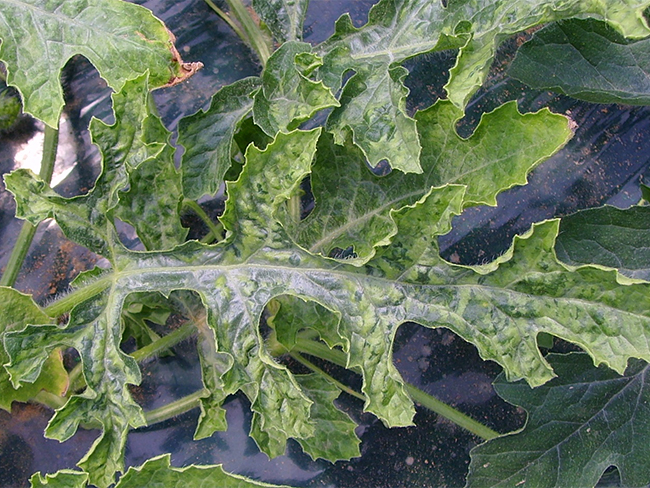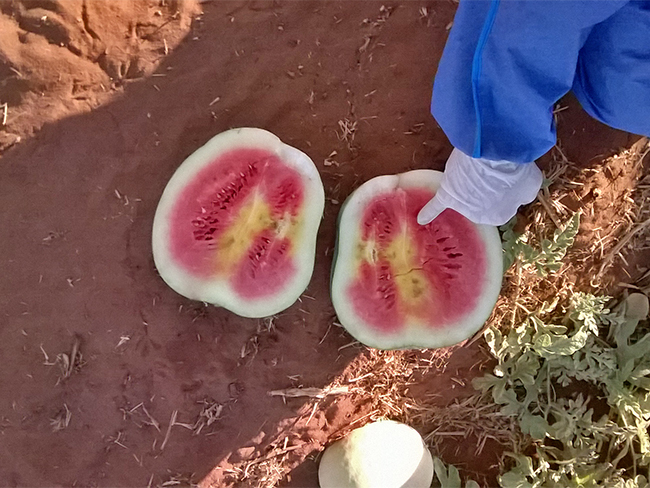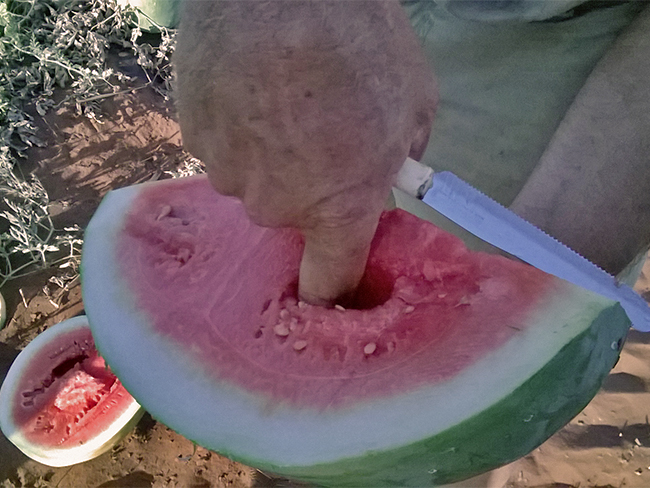Introduction
Cucumber green mottle mosaic virus is a plant disease found in Europe, Asia, the Middle East, some parts of the USA and Canada.
The virus was found in the Northern Territory (NT) in 2015. It has been accepted the virus can't be eradicated in the NT.
The focus is now on biosecurity and management to limit the spread of the virus.
It has been detected on 25 of 160 NT properties growing cucurbits. Most properties affected are large-scale watermelon farms.
It does not infect humans.
More information
For more information about cucumber green mottle mosaic virus, read the following fact sheets:
To read about NT research into the virus, go to plant industries research on the Department of Industry, Tourism and Trade website.
The virus has also been found in Queensland and Western Australia.
For more information about these cases, go to the following websites:
- Queensland Government's Business website
- Government of Western Australia's Department of Primary Industries and Regional Development website.
About cucumber green mottle mosaic virus
What the virus affects
The virus attacks plant cells through minute plant wounds.
It infects watermelon, cucumber, melons, zucchini, pumpkin, squash, bitter gourd, and bottle gourd - long melon - and some other species.
There are at least five strains of the virus, and symptoms can vary between hosts.
Other mosaic diseases, caused by potyviruses, are known to occur in northern Australia and can cause similar symptoms. This makes it difficult to identify it by sight. It can only be conclusively established by laboratory testing.
What affected plants look like
Infected watermelon plants can look bleached - the leaves having mosaic-like mottling - and the plant may be stunted.
Affected cucumber plants may also wilt and the runners, or the whole plant, may die prematurely.
Symptoms can include fruit abortion, uneven ripening, internal yellowing, breakdown of the flesh, and possibly a dirty red discolouration of the flesh. Infection may also cause fruit malformation.
The combined effects of the virus can cause substantial crop losses.
How it spreads
The virus can spread easily. The virus can stay alive for an extended time in plant debris and soil and on vehicles, equipment and tools.
Contaminated seed and soil are the most common ways the virus can be introduced into a crop. It can be transferred by sap or infected seeds, and remain dormant within the seed coat.
Regular handling of infected plants, such as when pruning or staking, can speed up the spread of the virus. Even a tiny injury caused by contact between plants can be enough to transfer the virus from one plant to another.
Ways it can spread include the following:
- by mechanical transfer, especially in protected or high-input culture systems where plants are frequently pruned, staked, handled or touched. This can occur via contaminated machinery, clothing, or even the hands of people who have come in contact with infected plants
- in field production by machinery and pickers
- infection of roots in soil that is contaminated with infected plant debris. The virus can spread through root-to-root contact
- in water or in nutrient solutions in soilless culture
- packaging materials such as bins used for harvesting, storage or marketing fruit - avoid recycling packaging materials
- infected rootstock plants and grafts
- seed harvested from infected plants
- insects such as pollinating honey bees.
Symptoms
Seedlings
It is hard to identify virus symptoms by sight, as they are very similar to symptoms caused by other cucurbit viruses.
Symptoms on young seedlings may be indistinct or difficult to recognise as being caused by a virus. In severe infections, embryonic leaves may become yellow, but symptoms may not be apparent until more mature leaves emerge.
Leaf
On young leaves, vein clearing and crumpling may be visible, while mature leaves may show mottling or mosaic patterns, or look pale, yellow, or bleached.
Fruit
Fruit may not show symptoms on the outside, or else can become severely spotted or streaked and distorted, especially during high temperatures.
In some cases, fruit with no signs on the outside can be discoloured or rotting on the inside. This is especially true for watermelon. In such cases, the watermelon fruit stalk has a dead area on it.
Biosecurity measures: cucumber green mottle mosaic virus
If you suspect the presence of cucumber green mottle mosaic virus on your property, call the hotline on 1800 084 881.
Farm biosecurity plan
If you grow cucurbits on your property you must have an approved biosecurity plan.
A plan should include all of the following measures:
- restrict access by farm visitors
- put up signs at the entrances to your property asking people not to enter
- use foot baths
- clean and disinfect tools and machinery
- sterilise vehicles, equipment, plant trays, tools, foot wear and personal items
- dispose of suspect plants and crop residues on site by burning or deep burial
- remove weeds that may harbour viruses in and around cucurbit crops
- develop a biosecurity kit for your farm.
How to develop a biosecurity kit and plan
Go to the Farm Biosecurity website for information and tools to help you develop a biosecurity kit and plan for your property.
If you need help developing your plan contact NT Farmers.
Restrictions on moving plants, seeds and soil
You must get approval to move any cucurbit-related material including soil, plants, seeds, seedlings and tissue culture.
Contact the Exotic Plant Pest Hotline on 1800 084 881 for information and advice.
Honey bees and CGMMV transmission
The findings of how honey bees move CGMMV are recorded in the research project - Understanding and managing the role of honey bees in CGMMV epidemiology.
For more information about the project go to the HortInnovation Australia website.
National management plan
The national management plan for cucumber green mottle mosaic virus has been developed by governments and industries affected by CGMMV to provide the Australian community and trading partners confidence that CGMMV is being actively managed in Australia.
The plan focuses on minimising the impact of CGMMV by preventing its spread, reducing the impact in affected regions and minimising the impact on domestic and international trade.
The plan focuses on early detection, isolation of suspect plants, measures to prevent infections and breaking the cycle of infection between growing cycles.



